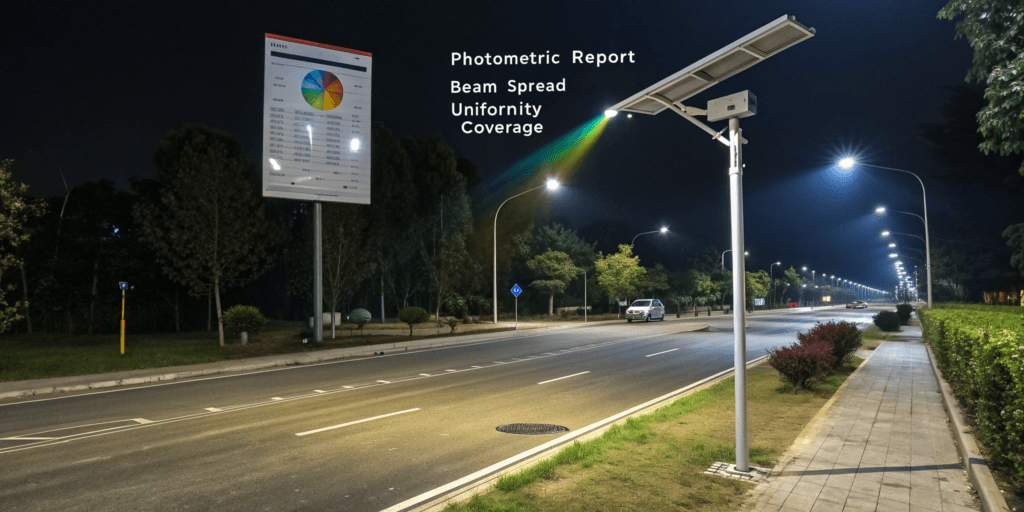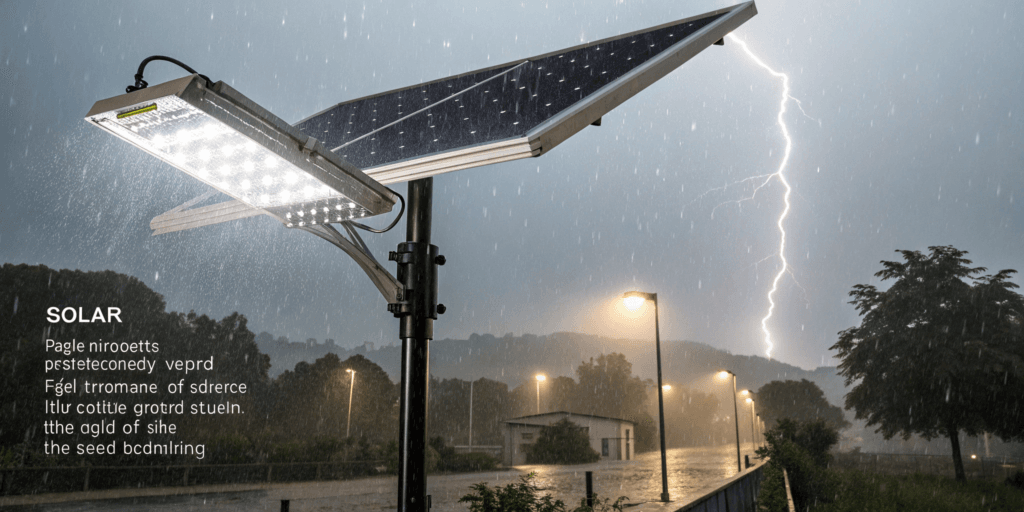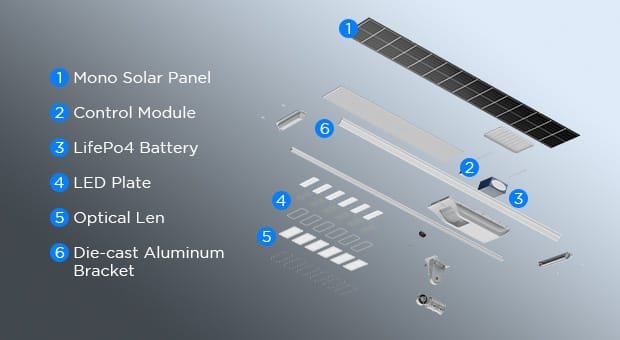If you’re unsure how to choose the right solar street light, you’re not alone. A wrong choice can lead to poor lighting, wasted money, and even project failure.
The smartest way to choose outdoor solar street lights is by asking the right questions—before you buy. This guide helps you do exactly that, step by step.
You don’t need to be an engineer to make a smart choice. You just need to be aware of the key performance indicators, common pitfalls, and supplier red flags.
Why Solar Street Lighting Is the Future of Outdoor Infrastructure?
The world is changing fast. Energy prices keep rising, and grid expansion is slow or impossible in many regions. You need reliable lighting—without high electricity bills.
Solar street lighting is the answer: it's cost-saving, off-grid, and sustainable. More countries are pushing green energy policies with incentives for solar adoption.
Solar lights don’t just cut long-term costs—they also reduce carbon emissions. Unlike traditional systems, there's no need to dig trenches, lay cables, or pay utility companies. This makes solar a perfect choice for rural roads, campuses, and even urban zones looking to modernize.
Why Governments and Businesses Are Shifting to Solar
- Energy Independence: No dependency on unstable grid supply.
- Scalability: Easy to deploy in remote or growing areas.
- Compliance: Aligns with eco-regulations and government green targets.
Typical Use Cases:
| Application | Solar Advantage |
|---|---|
| Rural roads | No grid needed, minimal maintenance |
| Industrial parks | Cut lighting costs, improve safety |
| University campuses | Easy to install, zero operational cost |
| Municipal projects | Government incentives, climate compliance |
When budget, time, and the environment are all concerns, solar is the smart, future-ready choice.
What Level of Lighting Performance Do You Need?
Some buyers get excited about “brightness” but forget how it actually works. Light quality isn’t just about intensity—it’s about coverage and consistency.
Most buyers should focus on lumens, lighting distribution, and how the light behaves in real-world conditions—not just on paper.
Let’s break it down:
Understand the Basics:
- Lumens = Total light output (not to be confused with watts)
- Mounting height affects how far and wide light spreads
- Spacing between poles determines uniformity and coverage
Don’t Skip Simulation Reports
Ask your supplier for a photometric simulation report. This shows how the light will perform in real conditions—on your road, not just in theory.
| Factor | Recommendation |
|---|---|
| Lumens | 3000–12000 lumens (depending on area size) |
| Mounting height | 4–8 meters for typical road/path lighting |
| Pole spacing | 20–40 meters for even distribution |
| Simulation report | Ask for it—it’s your proof of performance |
This is how I help our clients visualize before buying—so they get what they expect.
Which Battery Technology Is Used—and How Long Will It Last?
Not all batteries are created equal. The wrong type will fail early—especially under African heat and long rainy seasons. This is a major hidden cost for beginners.
LiFePO₄ batteries are your best friend. They’re safe, long-lasting, and more heat-resistant than older lead-acid or even basic lithium-ion cells.
Battery Tech Breakdown:
| Type | Lifespan (cycles) | Temp Tolerance | Maintenance | Price |
|---|---|---|---|---|
| Lead-Acid | 300–500 | Poor | High | Low |
| Lithium-Ion | 1000–1500 | Moderate | Medium | Moderate |
| LiFePO₄ | 2000–4000 | Excellent | Low | Higher up front, lower over time |
What to Ask:
- Battery capacity (Ah)?
- Cycles before replacement?
- Does it have BMS (Battery Management System)?
I always recommend asking for tech specs and a battery brand name. If a supplier avoids the topic, it’s a red flag.
How Efficient and Weather-Resistant Is the Solar Panel?
Your solar panel is the power source. If it's not good enough, your light won't last the night—especially in cloudy or dusty environments.
High-efficiency panels like monocrystalline types give more output from the same sun. They’re more expensive, but the return is worth it.
Compare the Options:
| Panel Type | Efficiency | Durability | Cost |
|---|---|---|---|
| Monocrystalline | 18%–22% | High (best choice) | Higher |
| Polycrystalline | 15%–17% | Medium | Lower |
Must-Haves:
- At least 18% efficiency
- Adjustable tilt for sun angle
- UV and hail-resistant glass
Good panel design can extend system life by years. We test every unit with water spray and UV light before shipping.
Will It Operate Reliably Every Night—Even in Rainy Weather?
What happens when it rains for three days straight? Your light better still work. Otherwise, the “off-grid” claim falls apart.
Smart systems store enough energy for 3–5 cloudy days and use motion sensors to conserve power.
Look for:
- Runtime: 8–12 hours per night
- Autonomy: 3+ cloudy days
- Dimming and motion sensors: Only use full brightness when needed
| Feature | Function |
|---|---|
| Autonomy time | Backup duration during bad weather |
| Motion sensor | Saves energy by reducing light when idle |
| Smart dimming | Adapts to traffic and human presence |
Our clients in Uganda love the auto-dimming feature—it cuts power use by 30% and still keeps roads safe.
What’s Included—and What’s Not?
Hidden costs can kill your budget. A cheap-looking quote might not include poles, brackets, or even cables. That’s how some suppliers lower prices on paper.
Checklist:
- Is the pole included?
- Are mounting brackets provided?
- Who installs the system—you or them?
Ask for a full scope of supply and a detailed drawing. This clears up everything before money is spent.
| Item | Often Included? | Confirm Before Buying |
|---|---|---|
| Solar panel | Yes | ✅ |
| LED fixture | Yes | ✅ |
| Battery | Yes | ✅ |
| Mounting bracket | Sometimes | ⚠️ |
| Pole | Sometimes | ⚠️ |
| Wiring | No | ❌ |
| Installation guide | Sometimes | ⚠️ |
Is the Supplier Reliable and Responsive?
Don’t judge by price alone. A great product from a bad supplier is still a bad deal. What if something goes wrong during installation? Will they pick up the phone?
What to Check:
- Do they offer technical support?
- Can they show project examples?
- Do they have local partners or reps?
I always share photos and reports from our installations in Ghana, Togo, and Uganda. It proves we’re not just another factory—we’re in the field with our clients.
| Trust Signal | Why It Matters |
|---|---|
| Project portfolio | Shows real-world results |
| Certifications | Confirms quality and export ability |
| Communication speed | Avoids delays and frustration |
| After-sales support | Ensures long-term system performance |
Conclusion
Making the right solar street light choice is about asking smart questions—not chasing low prices. A well-informed buyer avoids regrets and ensures long-term success.
💡 Need help designing the right solar street lighting solution? Contact us for a custom recommendation based on your site.
FAQ
How many lumens should a solar street light have?
It depends on the application: residential areas need 3000–5000 lumens, while highways may require up to 12000 lumens.
What type of battery is best for solar street lighting?
[LiFePO₄ batteries](## Which Battery Technology Is Used—and How Long Will It Last?
Not all batteries are created equal. The wrong type will fail early—especially under African heat and long rainy seasons. This is a major hidden cost for beginners.
LiFePO₄ batteries are your best friend. They’re safe, long-lasting, and more heat-resistant than older lead-acid or even basic lithium-ion cells.
Battery Tech Breakdown:
| Type | Lifespan (cycles) | Temp Tolerance | Maintenance | Price |
|---|---|---|---|---|
| Lead-Acid | 300–500 | Poor | High | Low |
| Lithium-Ion | 1000–1500 | Moderate | Medium | Moderate |
| LiFePO₄ | 2000–4000 | Excellent | Low | Higher up front, lower over time |
What to Ask:
- Battery capacity (Ah)?
- Cycles before replacement?
- Does it have BMS (Battery Management System)?
I always recommend asking for tech specs and a battery brand name. If a supplier avoids the topic, it’s a red flag.
How Efficient and Weather-Resistant Is the Solar Panel?
Your solar panel is the power source. If it's not good enough, your light won't last the night—especially in cloudy or dusty environments.
High-efficiency panels like monocrystalline types give more output from the same sun. They’re more expensive, but the return is worth it.
Compare the Options:
| Panel Type | Efficiency | Durability | Cost |
|---|---|---|---|
| Monocrystalline | 18%–22% | High (best choice) | Higher |
| Polycrystalline | 15%–17% | Medium | Lower |
Must-Haves:
- At least 18% efficiency
- Adjustable tilt for sun angle
- UV and hail-resistant glass
Good panel design can extend system life by years. We test every unit with water spray and UV light before shipping.
Will It Operate Reliably Every Night—Even in Rainy Weather?
What happens when it rains for three days straight? Your light better still work. Otherwise, the “off-grid” claim falls apart.
Smart systems store enough energy for 3–5 cloudy days and use motion sensors to conserve power.
Look for:
- Runtime: 8–12 hours per night
- Autonomy: 3+ cloudy days
- Dimming and motion sensors: Only use full brightness when needed
| Feature | Function |
|---|---|
| Autonomy time | Backup duration during bad weather |
| Motion sensor | Saves energy by reducing light when idle |
| Smart dimming | Adapts to traffic and human presence |
Our clients in Uganda love the auto-dimming feature—it cuts power use by 30% and still keeps roads safe.
What’s Included—and What’s Not?
Hidden costs can kill your budget. A cheap-looking quote might not include poles, brackets, or even cables. That’s how some suppliers lower prices on paper.
Checklist:
- Is the pole included?
- Are mounting brackets provided?
- Who installs the system—you or them?
Ask for a full scope of supply and a detailed drawing. This clears up everything before money is spent.
| Item | Often Included? | Confirm Before Buying |
|---|---|---|
| Solar panel | Yes | ✅ |
| LED fixture | Yes | ✅ |
| Battery | Yes | ✅ |
| Mounting bracket | Sometimes | ⚠️ |
| Pole | Sometimes | ⚠️ |
| Wiring | No | ❌ |
| Installation guide | Sometimes | ⚠️ |
Is the Supplier Reliable and Responsive?
Don’t judge by price alone. A great product from a bad supplier is still a bad deal. What if something goes wrong during installation? Will they pick up the phone?
What to Check:
- Do they offer technical support?
- Can they show project examples?
- Do they have local partners or reps?
I always share photos and reports from our installations in Ghana, Togo, and Uganda. It proves we’re not just another factory—we’re in the field with our clients.
| Trust Signal | Why It Matters |
|---|---|
| Project portfolio | Shows real-world results |
| Certifications | Confirms quality and export ability |
| Communication speed | Avoids delays and frustration |
| After-sales support | Ensures long-term system performance |
Conclusion
Making the right solar street light choice is about asking smart questions—not chasing low prices. A well-informed buyer avoids regrets and ensures long-term success.
💡 Need help designing the right solar street lighting solution? Contact us for a custom recommendation based on your site.
FAQ
How many lumens should a solar street light have?
It depends on the application: residential areas need 3000–5000 lumens, while highways may require up to 12000 lumens.
What type of battery is best for solar street lighting?
LiFePO₄ batteries offer the longest life and best temperature tolerance, especially for hot or rainy climates.
Can solar street lights work during cloudy or rainy days?
Yes, if the system has good autonomy—look for at least 3 days of stored energy and smart dimming features.
What is the typical lifespan of outdoor solar lights?
High-quality systems last 5–10 years, depending on battery and material quality.
How do I install a solar street light system?
Some systems are DIY-friendly, but for large projects, it’s best to use trained professionals and follow local codes.
What’s the difference between monocrystalline and polycrystalline panels?
Monocrystalline panels are more efficient and durable but cost more. Polycrystalline panels are cheaper but less efficient.
Do solar street lights require maintenance?
Minimal—just clean the panels and check the battery once or twice a year.
) offer the longest life and best temperature tolerance, especially for hot or rainy climates.
Can solar street lights work during cloudy or rainy days?
Yes, if the system has good autonomy—look for at least 3 days of stored energy and smart dimming features.
What is the typical lifespan of outdoor solar lights?
High-quality systems last 5–10 years, depending on battery and material quality.
How do I install a solar street light system?
Some systems are DIY-friendly, but for large projects, it’s best to use trained professionals and follow local codes.
What’s the difference between monocrystalline and polycrystalline panels?
Monocrystalline panels are more efficient and durable but cost more. Polycrystalline panels are cheaper but less efficient.
Do solar street lights require maintenance?
Minimal—just clean the panels and check the battery once or twice a year.





